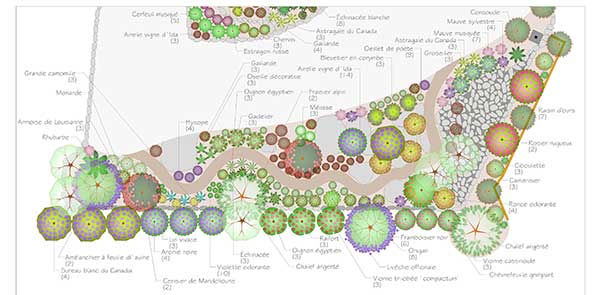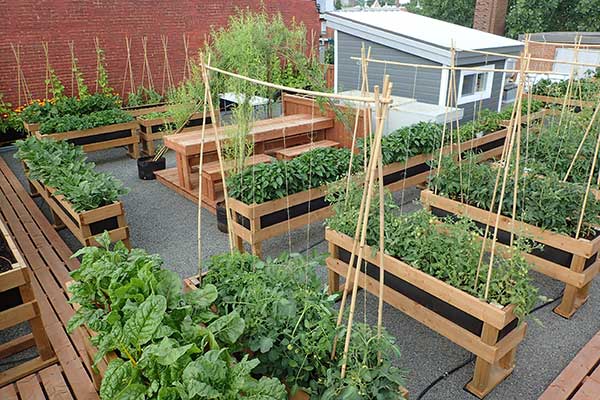With manicured lawns and perfectly trimmed shrubs, the landscaping surrounding North American homes and buildings was, until recently, mostly considered decorative. However, a new way of designing gardens, particularly appreciated by millennials, has just made its appearance: foodscaping!
A Functional, Ecological and Productive Garden

The principle of foodscaping is simple because it involves designing gardens in which edible plants are grown. By making your own edible landscaping, you will be able to create a functional and ecological living environment that will allow you to produce organic, fresh, tasty and inexpensive food!
Nut trees, fruit trees and shrubs, perennial or tropical vegetables, herbs, edible flowers and medicinal plants; any of these has its place in edible landscaping. They have the ability to produce vegetables and fruits in abundance, year after year, with little maintenance. As it is the case for permaculture, edible landscaping is also a sustainable ecosystem that respects living creatures in which interventions are minimal.

(illustration: Guillaume Pelland, Paysage Gourmand).
A Landscaping Just As Good As Beautiful
Vegetables are considered by a majority of people to be quite unattractive, so they are often grown in a corner of the land far from the house. On the other hand, since it consists of plants that are just as beautiful as they are edible, foodscaping can be achieved almost anywhere: on the front land of a residence, on a terrace or even on a roof!
Numerous edible plants, such as Swiss chard (Beta vulgaris var. cicla), strawberries (Fragaria x ananassa), kale (Brassica oleracea var. acephala), scarlet runner beans (Phaseolus coccineus) and peppers (Capsicum annuum), for example, are just as decorative as most annual and perennial flowers. Furthermore, to make your foodscaping as aesthetic and colourful as possible, you can associate edible flowers, such as carnations (Dianthus) and pansies (Viola x witrockiana), with most vegetables.
If you have a mature garden, an easy way to incorporate edible plants is to introduce those with ornamental qualities into your flower beds. Gradually, you will be able to transform some of your non-productive borders into edible and utilitarian landscaping.

(Brassica oleracea var. acephala ‘Redbor’) with purple edible foliage
(photo: Albert Mondor).
An Edible Garden With Style
What materials should be used for the creation of foodscaping? Apart from the fact that it is better to choose materials that are in harmony with those of the house, there is no established rule. Some will prefer modern materials such as cut stone and stainless steel, while others will want old farmhouse materials such as rusty steel, barn wood and straw bales. The recovery of used materials for the creation of edible landscaping is particularly popular among millennials.
A Well-Structured Foodscaping
If you want to be successful at creating edible landscaping at home, make sure that you plant fruit trees. In addition to maximizing the use of space, these plants form the backbone of a garden since they are, in a way, pivots around which the lower edible plants are then placed.
You can opt for an apple tree or a cherry tree, but these species should be reserved for experienced gardeners. I suggest you plant hardy small fruit trees which produce little shade and require little maintenance, such as serviceberry (Amelanchier alnifolia), sea buckthorn (Hippophae rhamnoides) or Asian pear (Pyrus pyrifolia).
If you live in an urban environment and your land is particularly small, plant hardy kiwi (Actinidia kolomikta), a climbing fruit species with beautiful variegated foliage producing an abundance of edible sweet berries very rich in vitamin C!
Many species of fruit shrubs can be easily incorporated into edible landscaping. Highbush blueberries (Vaccinium corymbosum) and raspberries (Rubus idaeus) are certainly the most popular. In addition, many recently introduced cultivars, including Raspberry Shortcake™ (Rubus idaeus Raspberry Shortcake™), are small in size and are well adapted to be grown in containers in urban gardens.
Some native fruit shrubs such as black chokeberry (Aronia melanocarpa), honeyberry (Lonicera caerulea var. edulis) and black elderberry (Sambucus canadensis) are very popular among younger generations of gardeners.

(Lonicera caerulea var. edulis) produces elongated berries
very rich in antioxidants (photo: Albert Mondor).
A Perennial Edible Garden
The herbaceous edible plants (perennial and annual vegetables, herbs, edible flowers and medicinal plants) can be arranged very creatively at the base of shrubs and trees. It is possible to associate edible plants the same way one creates an ornamental border, according to their height, shape, texture and colour.
To facilitate the maintenance of edible landscaping, it is advisable to plant herbs and perennial vegetables. Among the most easy to grow perennial edibles are the Egyptian onion (Allium cepa var. proliferum), a perennial plant that is a good substitute for the common onion; skirret (Sium sisarum), which has a sweet and long white root that looks like parsnip; sea kale (Crambe maritima), whose fleshy leaves have a concentrated taste of cabbage, and Jerusalem artichoke (Helianthus tuberosum), whose artichoke-flavoured root is very rich in fructans – considered as prebiotics that participate in the balance of the intestinal flora – and is a wonderful substitute for potato. However, this plant is particularly aggressive, so it is necessary to install it in a large pot buried in the ground or to surround it with a thick metal border.

has a powerful and delicious taste like cabbage
(photo: Albert Mondor).
In addition to growing perennial plants – which should not be replanted each year – the maintenance of edible landscaping can be reduced by planting veggies in a manner that their foliage is touching. It is also possible to cover the ground with organic mulch or to plant groundcovers that densely cover the soil while producing edible crops such as alpine strawberries (Fragaria vesca var. semperflorens) and lingonberries (Vaccinium vitis-idaea). Finally, rather than placing plants in clumps or rows, opt for a more natural planting method based on a great diversity of plants.

flowers will be less easily spotted by the cabbageworm
(photo: Albert Mondor).
A Smoothie Garden On Your Terrace
Are you a smoothie lover? It’s easy to create a small garden including some of your favourite plants to make delicious smoothies! Just plant them in containers on your balcony or terrace near your kitchen. Kale ‘Darkibor’ (Brassica oleracea var. acephala ‘Darkibor’), Strawberry Natural Albino® (Fragaria x ananassa Natural Albino®), Malabar spinach (Basella alba) and Blueberries Jelly Bean™ (Vaccinium corymbosum Jelly Bean™) are among the easiest plants to grow in pots and will do wonders in your smoothies!
Container Foodscaping

(photo: Jean-Philippe Martin/La Shop agricole)
Since more than 75% of North American and European populations now live in urban settings, many of them do not have a lot of space to create a garden. They must grow edible plants in pots on balconies, terraces, roofs or even walls. Several small edible plant varieties have been developed in recent years to be grown in containers. Furthermore, various shrubs such as raspberries, honeyberries and sea buckthorns, as well as some herbaceous plants such as chives (Allium schoenoprasum), marjoram (Origanum majorana) and several species of rambling stonecrops (Sedum) easily survive harsh winters in northern America and Europe, especially if they are grown in textile pots (like Smart pot) promoting excellent drainage and some insulation.
This opens up a new world of garden design that is understandable and makes sense. thank you
Thank you so much for sharing these wonderful resources. I’m still a bit of a novice, but these foodscape images look beautiful and I love their functionality. Keep up the great work!
Don’t make us blush! Thank you.
The print in your article is not clear enough to read, sadly. I wanted to read it.
Hi Joan,
Thanks for your feedback! We’ve darkened the font – I hope this helps!
Happy Gardening!
Luckily my deed restrictions are very old and didn’t specify what kinds of plants I have to have in my yard. My front yard medians along the street are lined with kale, swiss chard, mind and lots more. I get some frowns as this is not the manicured lawn of my neighbors, but mostly its well received. Always good for conversation especially when I put out signs say “Swiss Chard Eaters Needed – help yourself!”
How is this new? People have been doing formal landscape edible gardens for a long time. Look at the potagers of the 1800s. They were even ahead of what most people do today in regard to season extension. Hot beds FTW.
Please, I would love to see the foodscping design plan on a larger scale so I can read the plants used.
Hello Carolyn,
I don’t have a larger image, but I added in a link to the designers’ website who has multiple plans! Enjoy!
http://paysagegourmand.ca/plan-architectural/
Great ideas!
Love your foodscaping ideas and container gardening
I hope I can talk my neighbors into more space like this .
We better have a fund raiser .
I really love the artical !
This is an excellent Garden Article shared to the 3 social media FaceBook accounts of Holistic Chef Barry Anderson to help the world to STOP GROWING GRASS UNEDIBLE LAWNS THAT IS EXPENSIVE AND TOXIC TO THE ENVIRONMENT AND TO HUMAN HEALTH. The Garden Villa Phuket Thai Nature Retreat located on the resort island of Phuket Thailand has built attractive raised beds around mature tropical fruit trees such as Noni, Mango, Banana with ornaments of different palms and Flowering trees for the pollinators so essential for all life for this good Earth we like to call our home. The footpaths are flat stone and slate with green grout mixed with the sand wash.Important to note that all mature trees with surface roots need to breath and grow so do not cement so deeply into the footpath near the big tree. So do this instead. Make a raised above ground footpath or bridge and add a nice overhang roof for the tropical rainy seasons. The photo will be provided later. We must protect the root network systems of our Mother Nature Trees at all costs in life. Thank You “Your Good Earth Chef and Friend for Life. Holistic Chef Barry Anderson PS: IMPORTANT NOTE . YOUR GARDEN MUST BE ORGANIC ONLY ….BOYCOTT ALL THE CHEMICAL PRODUCTS THEY DO YOU NO GOOD AND MUCH HARM TO YOU AND TO YOUR ENVIRONMENT . Thank You
Loved this article. Our house has a mostly sunny front yard but deep shad back yard so growing edibles there is not an option. For the past 3 years we’ve planted tomatoes and peppers and herbs, but will expand our choices. We also have 2 butterfly gardens which replaced our former beloved rose gardens which were constantly plagued with Japanese beetles, fungus and all kinds of rose diseases (removed 2 years ago). I need to get the revised copy of Edible Landscaping and start planning our 2019 edible front yard!
It was called “edible landscsaping” when Rosalind Creasy first wrote her book about it in 1982. She revised the book and it was reissued by Sierra Club Books in 2010.